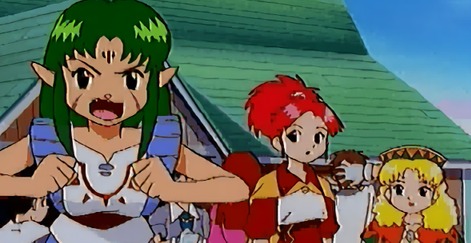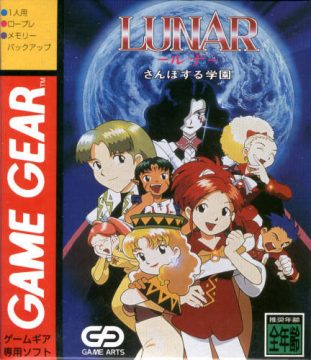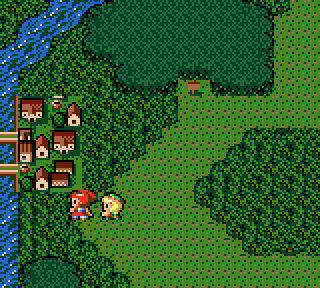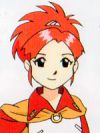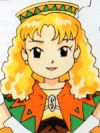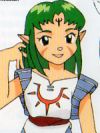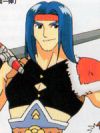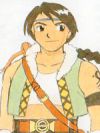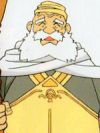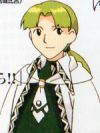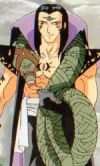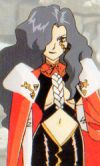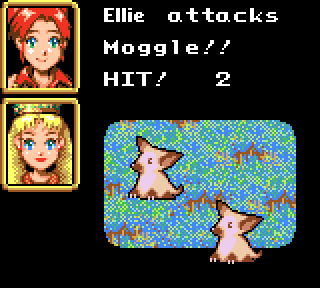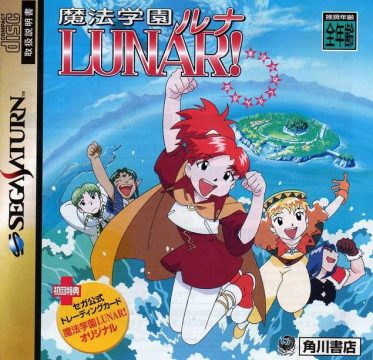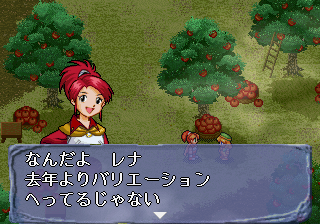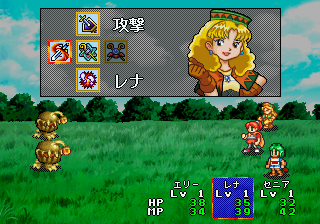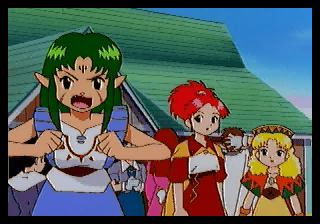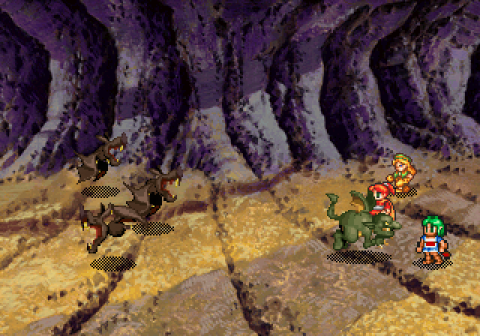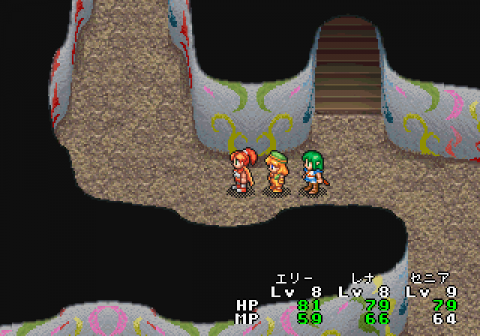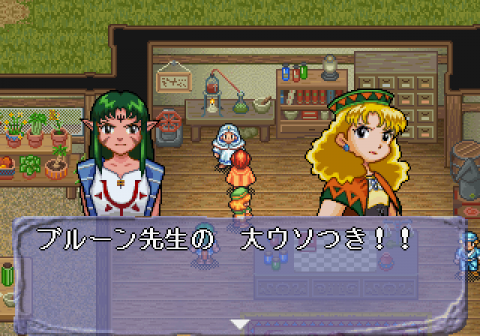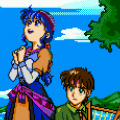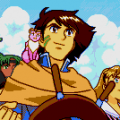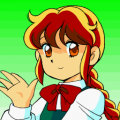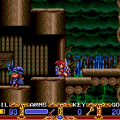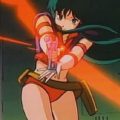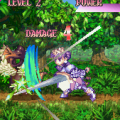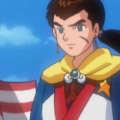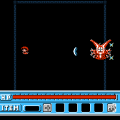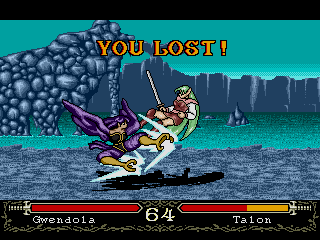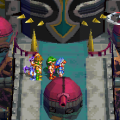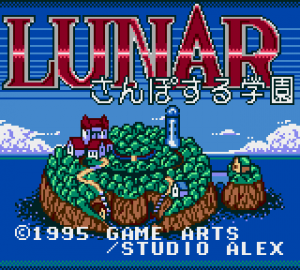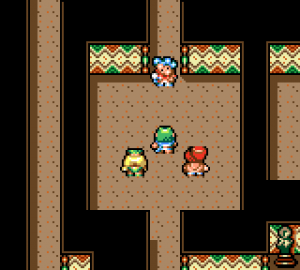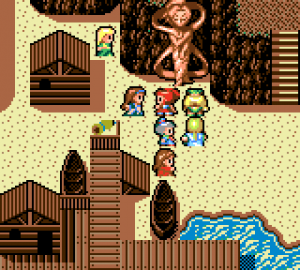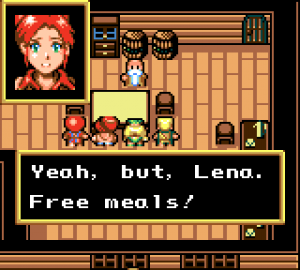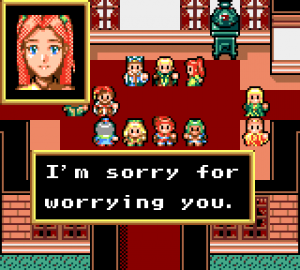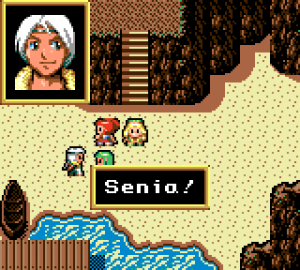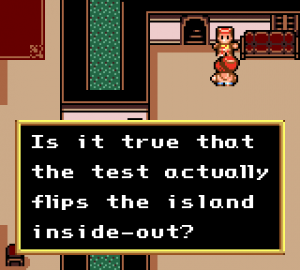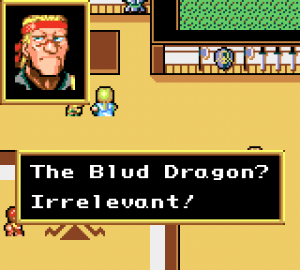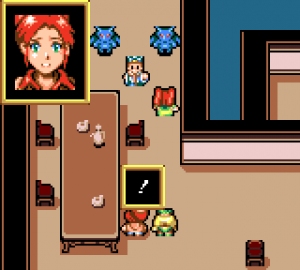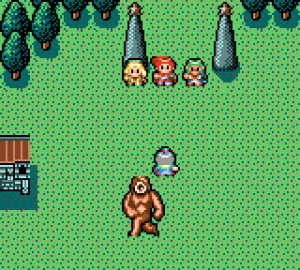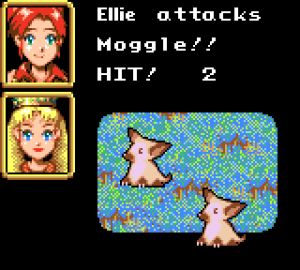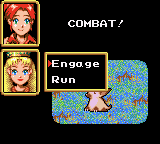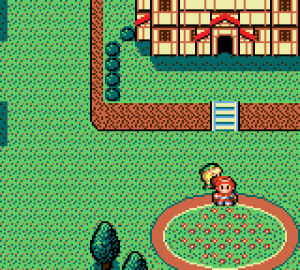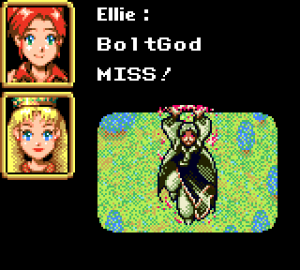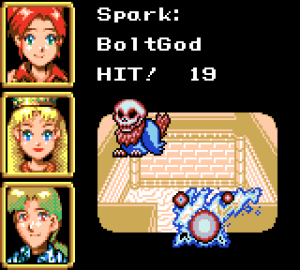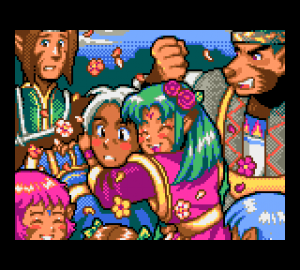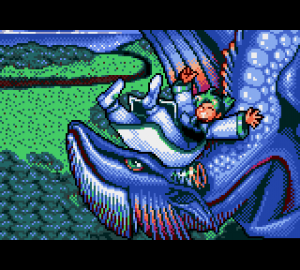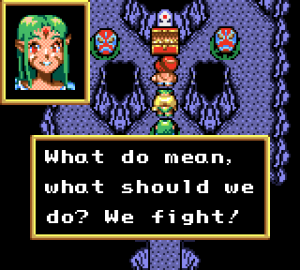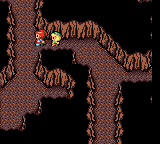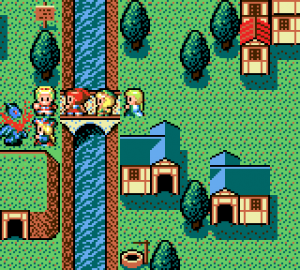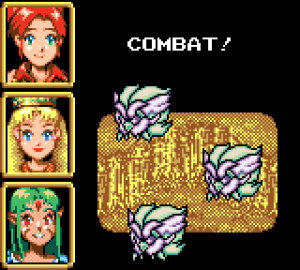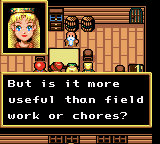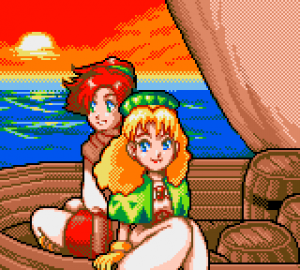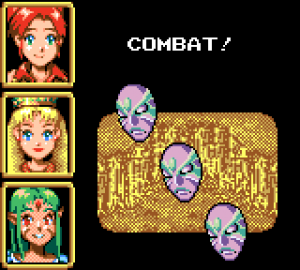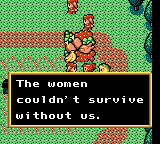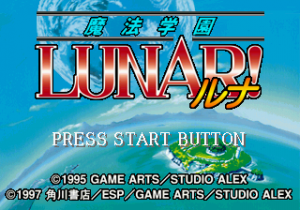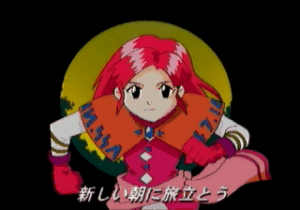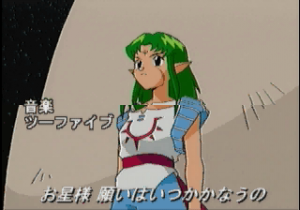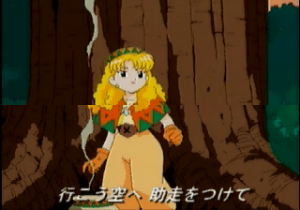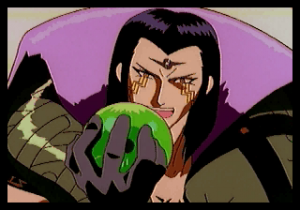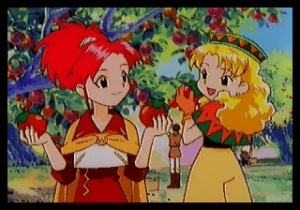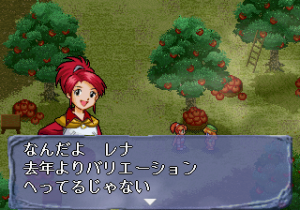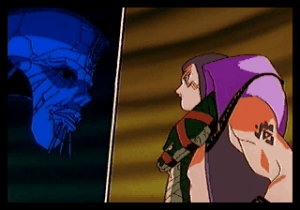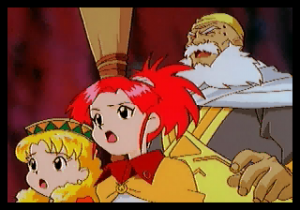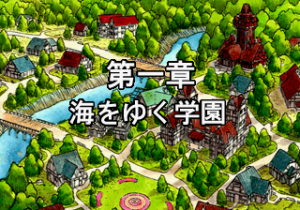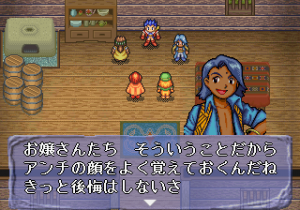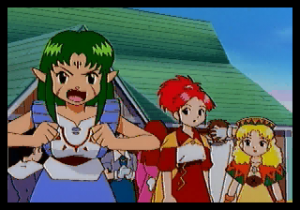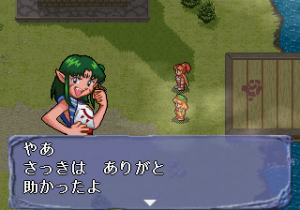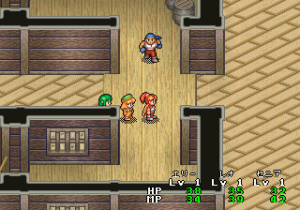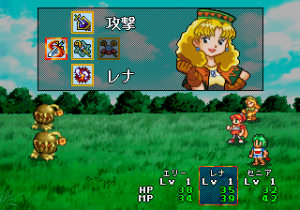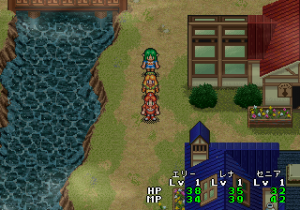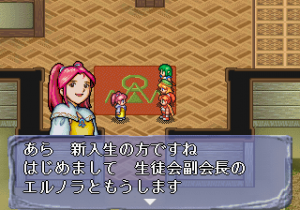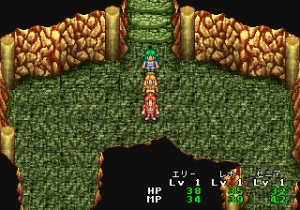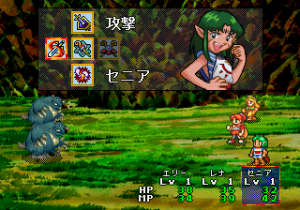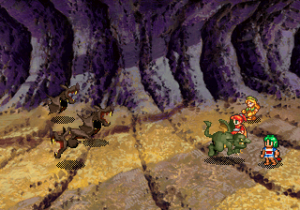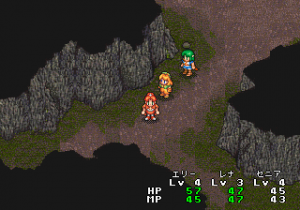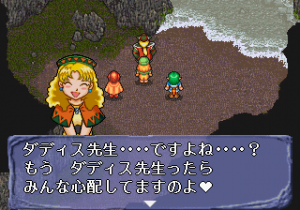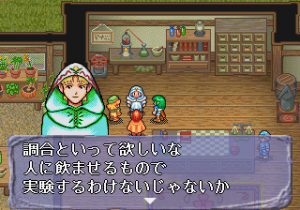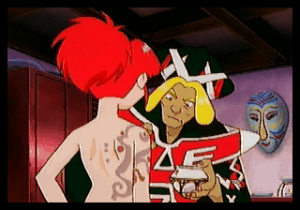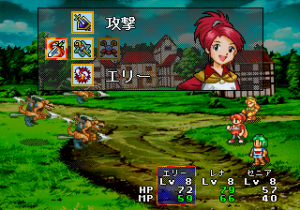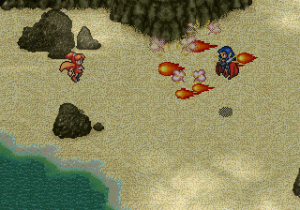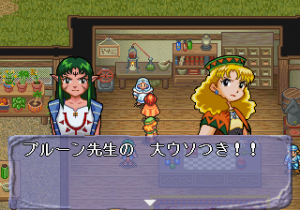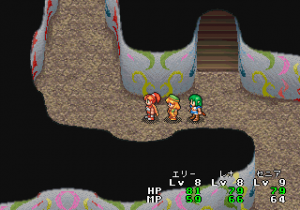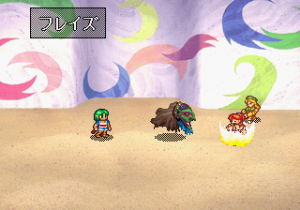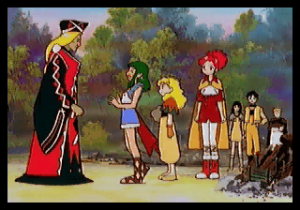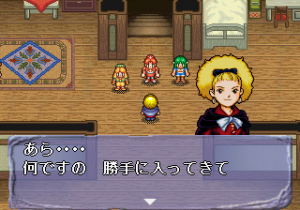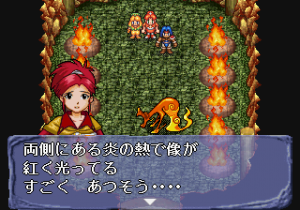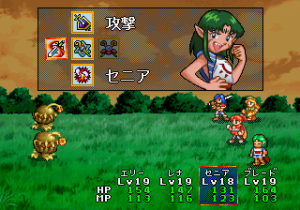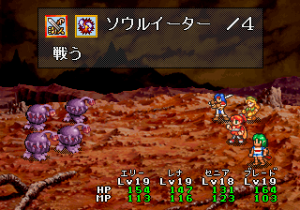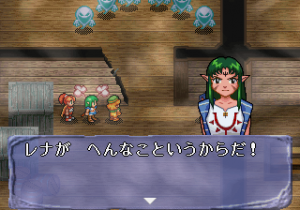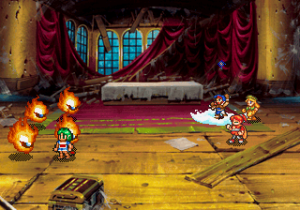- Lunar: The Silver Star
- Lunar: Eternal Blue
- Magical School Lunar
- Lunar: Dragon Song
The most popular console RPGs often received portable counterparts, games that purported to offer similar (but different) experiences in spite of the smaller hardware. In Lunar’s case, it received a spin-off for the Game Gear known as Sanposuru Gakuen (“Strolling School”). Like its 16-bit Sega CD brothers, it also received a 32-bit makeover for the Saturn, where the title was changed to Mahou Gakuen (“Magical School”). While the central concept, cast of characters, and basic plot beats are the same across both titles, they’re otherwise almost entirely different games.
The story takes place a few hundred years before the original Lunar. Two girls from the town of Burg, Ellie and Luna, are scouted to attend a magical school on the floating island of Ien. The duo is eager to receive an education to escape their boring life (and get free meals), though their enthusiasm is dampened when the only teacher willing to take them on is an incompetent nitwit who excels in “cosmetic magic” (i.e. using makeup to create magic). The other teachers are similar oddballs, including the instructor who’s obsessed with manliness and insists on impossible tasks in the name of masculinity.
As the school year goes on, eventually they have to contend with two villains, who have their own floating island that houses a castle called “D”. The game is divided into twelve chapters, most just focusing on small vignettes around the school, slowly revealing the bad guys and then the hero’s attempts to stop them. There’s no real connection to the main Lunar games, though it obviously takes place in the same world – Ien is similar to Vane from those games (though not as big or prestigious), and it makes references to the Vile Tribe and other familiar names. At one point, Ellie is even mistaken for the reincarnation of Althena, which gets her in trouble.
Characters
Ellie
The protagonist, who, like Alex from Silver Star Story, is fairly quiet compared to the personalities around her. In the Saturn remake, her main magic power is the ability to fly.
Lena
Ellie’s loudmouth friend, also from the town of Burg. She’s self-conscious about her short stature and generally quick to anger, in spite of her sweet personality.
Senia
A beast girl, similar to Jessica and Mel from the original game. She rounds out the trio of girls featured in the first half of the game.
Blade
An arrogant swordsman who acts as this game’s Kyle, though with less innuendos. Only appears in the Saturn version.
Azu
One of the chapters features Azu, who hops on to Iyen to track down Senia in order to marry her. He’s an NPC in the Game Gear game but upgraded to full party member in the Saturn version.
Glen
There are several teachers in the magic school, though they don’t really join you, except for old man Glen, who lives a short distance away. Like Ghaleon from the original game, he pops in the party for a bit, and, at level 99, is much more powerful than the main crew.
Wing
A young boy (and only male party member in the Game Gear version) who shows up for the second half of the game. He’s shy and has a crush on Ellie, though he can’t really admit it.
Memphis
One of the antagonists, he commands the castle of D and the strange disembodied face that controls it.
Barua
A member of the Vile Tribe, she uses her charms to influence the male attendees of the magic school.
Outwardly, the Game Gear release resembles Dragon Quest, complete with squat sprites, random battles, and a fairly standard first person battle system. As expected given the setting, combat places a greater emphasis on magic than the main Lunar games, with many enemies having particular elemental weaknesses, and each of the characters have attacks to exploit them. As usual with JRPGs, magic power is limited, but there are restorative health items, and a number of robes that will regenerate MP as you walk around. Magic is obtained by speaking to certain instructors once you’ve reached high enough levels.
Mahou Gakuen Lunar! (魔法学園LUNAR!) – Sega Saturn (1997)
Outside of the story and writing (and the tiny character portraits), Samposuru Gakuen doesn’t really feel like a Lunar game, because there’s only so much that a Game Gear can do. This was rectified with the Saturn version, released almost two years later. This includes completely redone visuals, redone music, about 30 minutes of animated cutscenes, and a new battle system.
The game uses the same twelve chapter structure, but with a few exceptions, what actually happens in those chapters is almost completely different. The Game Gear version began with a trial, as the students were met with an empty island and needed to figure out how to survive. The Saturn version skips over that completely and starts with the gang trying to match their talents and find a suitable professor. The villains are introduced much, much earlier – Memphis appears in early cutscenes, and Barua is introduced in the second chapter, where previously she didn’t show up until about the eighth, the same time when Wing is introduced. The Game Gear version features a chapter where the island docks with a town called Shell; the Saturn version has a chapter focusing on a mysterious mist and a ghost ship, and another one about visiting a town of merfolk. In one of the middle chapters of the Game Gear version, Senia’s boyfriend shows up, and then she leaves with him, never to return. In the Saturn version, she returns a little bit later, and even her husband joins the party. A new character, Blade, also shows up in the fourth chapter, giving another personality to bounce off the main girls, as well as providing someone who isn’t useless with physical attacks. The script is, of course, entirely rewritten and greatly expanded, which is a huge benefit, considering much of the game is simply spent running around the school and talking to the various instructors and classmates.
The visuals are done in the style of the other 32-bit Lunar ports. It’s not entirely the same since they use more realistically-proportioned sprites as opposed to the super deformed ones of the other games, but they still look similar. What is odd is that the battle scenes use a different set of sprites than the field, and they look markedly worse. There’s an opening video with a vocal theme, and plenty of anime scenes peppered throughout. They are somewhat hampered by the Saturn though, with the video having a noticeable border and suffering from heavy compression artifacts – unlike the other Lunar ports, there was never any support for the MPEG card or PlayStation ports to clean them up. There’s also some computer generated graphics in the later sections, depicting the island and castle, which look painfully dated. The music is provided by Noriyuki Iwadare once again, and maintains both the playful town themes and powerful battles themes of his previous works. Some of the tracks are redbook too, so these actually sounds better than the Saturn/PS1 ports.
The battle scenes look like the other Lunar games, but it doesn’t quite play like them. Gone are the movement limitations and multiple turns, though area of effect spells are still present. It does boast six party members in combat at once, one more than the other Lunar games, and double the amount from the Game Gear game. As with before, much of the fighting is based on exploiting elemental weaknesses by using specific spells. Also new are fusion spells – if two characters use (pre-determined) compatible spells, the game will give a hint that you can learn something new. Then you trek back to one of the professors, who will then teach you that spell.
While there’s nothing particularly wrong with the combat system, everything begins to fall apart due to one major factor – the excruciating random encounter rate. You can barely take more than a few steps (sometimes less) before being stopped and dragged into a fight, complete with load times and no way to speed up the combat animations. It’s a particularly striking issues since the other 32-bit Lunar remakes did away with random encounters entirely, but they’re back here and worse than they’ve ever been.
This has a cascading effect that ends up creating even more tedium. The Game Gear version didn’t have much in the way of equipment other than magic robes but it did have restorative items. The Saturn version abolishes both of those completely, along with removing any currency. You still gain MP by walking around…but the encounter rate is so brutal that you’ll be lucky to regain even one or two points before you’ll need to drain them again for combat. Without health restoratives, the alternative is…yup, magic spells, putting more of a drain on your MP. Defending while in combat will restore a small amount, so the only way to get anywhere without running out of magic is reducing a battle scene to a single foe, then having everyone defend for multiple turns until they’re at full power again. There are also other issues – with no items or money, there’s no reason to explore dungeons outside of just finding your way to the end. And while they aren’t complicated, combined with all of the combat, they do feel very, very, very long. There are a few cases where you can find healing statues, but sometimes they’re so far out of the way that reaching them (and heading back to the main page) takes so long, and drains so much, that it’s just not worth it.
According to various stories on the Japanese internet, this was the result of development issues. The Lunar series to this point had always been a joint effort between Studio Alex and Game Arts. However, apparently due to publisher demands, the game was shaping up to be too short. Despite the expanded script and all of the cutscenes, it’s still based around the same twelve chapter structure as the Game Gear game, and thus was fairly short for an RPG, where expectations are for at least 20 hours of gameplay. Game Arts requested an expanded scenario from Studio Alex, but they were unable to finish anything by the deadline. So, Game Arts hired an external studio (Bits Laboratory, who worked on many outsourced projects) to cobble something together to get the game in a releasable state. And in order to meet the play time requirements, the random encounter rate was adjusted to add as much padding as possible.
Even without taking that into account, Mahou Gakuen isn’t exactly a classic. It’s still fairly short, taking place almost entirely on a small island, along with the handful of locales it docks with. Even on the Saturn, it’s very obviously based on a portable game that was initially developed for a much smaller scale. That being said, even though there’s no direct connection, it still feels very much like a Lunar game, particularly in the humor and character interactions.
The fact that the main characters are all kids is both a positive and a negative. Much of the game is watching cutesy girls do cutesy, silly things, and it’s fun to exist in a game world where the main point is just to have wacky hijinx, something the Lunar series has excelled at. It does go a bit overboard with the constant rivalry between a gang of (comparatively incompetent) boys though, and of course anyone expecting grand adventure will find it disappointing. This “moe” appeal is cited as one of the reasons why Working Designs passed on the project.
But there’s some weirdness that manifests itself in other ways. An early scene in the Saturn version has Ellie stripping her clothes off so her teacher, an adult man, can paint on her. For magical purposes, of course. Nothing is presented as predatory, but it’s still creepy. About halfway through, two of the characters get married. Teenage marriages have been a thing throughout history and fiction, but considering the tone of the game, it’s still incredibly bizarre to see fourteen year olds on their honeymoon. And Barua’s infatuation with young boys is one of those things that’s called out as disturbing even by the other characters. There have been hundreds of villains in RPG history, having committed all kinds of acts of genocide, but this is one of the few to actually feature an implied pedophile.
Some of this stuff is creepy, though it doesn’t ruin the game. No, the random encounters ruin it. There’s some silly fun to be had, but the rest is wasted on the tedium. The Game Gear version steers close of most of this – the random encounter rate is still high but the fights are quick – but as a simple 8-bit RPG, it’s too stripped down to get much out of.
Despite the reaction towards the Saturn version of Mahou Gakuden, there was still quite a bit of media produced for it, including a manga series and even a ten minute gag OVA. The episodic format of the game is more suitable towards media like this, but it’s still disappointing that such efforts were concentrated on a game that’s basically a flop.
Links:
http://www.lunar-net.com/ms/characters.php – Character art from here
https://lparchive.org/Lunar-Walking-School/ – Game Gear screens (fan-translated) from here
